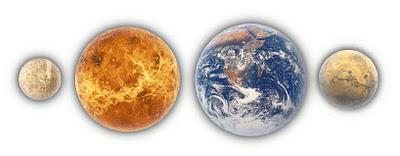The relatively small inner planets have solid surfaces, no system of rings, and with few or no satellites. Atmosphere of Venus, Earth and Mars contain a substantial amount of carbon dioxide (CO2). In the inner solar system only Earth has a magnetic field (magnetosphere) that protects the planet from radiation from the interplanetary medium. The inner planets have a rocky composition and density greater than 3 g/cm3.

Mercury is the smallest inner planet and the closest to the Sun, and it is difficult to observe from Earth. Greek astronomers gave it two names, although they knew that it was a one planet. When Mercury appeared at dawn they called him Apollo, and Hermes in the evening. Venus is the third brightest body in the sky so it is known from ancient times and people. As with Mercury during the ancient time Greek had two names for Venus, although the Greek astronomers knew that it was one and the same body. Ezofor as the morning star and Hesperus as the nighttime star. Planet Earth is, for now, the only planet in our solar system that is seen in a unique way. Mars and Venus and Mercury are well known to people even before the emergence of ancient civilizations. Many believed that there are aliens on Mars.
The inner planets were built mostly of rock, and it is assumed that their inner core is of iron. For the inner planets differ bottom conjunction, when the planets are between Earth and Sun, and the upper when the planets are on the opposite side of the Sun. The inner or lower planets have an angular distance from the Sun, and differ depending on the position of the eastern and western elongation. Such planets we observed in the evening (east) or morning (west). Under certain conditions the planets in conjunction can not exceed the lower front of the Sun and these transits can be observed.
